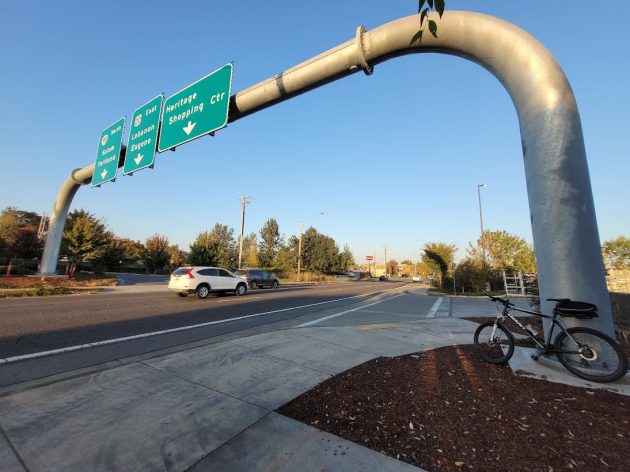
The completed new sign bridge on Ninth Avenue ahead where Oregon 99E and US20 split.
If you’re wondering how much this massive new sign bridge on Ninth Avenue in Albany has cost, read on.
The structure is bigger than what you’re used to seeing around here. It was installed as part of a $4.1 million ODOT project intended to increase traffic safety on Highway 20 (Santiam Highway) between the junction with US99E (Ninth Avenue) and Waverly Drive to the east.
There are reasons why the sign bridge is as big as it is.
One reason, says ODOT public information officer Angela Beers-Seydel, is that since 2002 the Oregon Department of Transportation has standardized the design of sign structures to fit most locations in the state. So the design has to withstand the most severe wind storms.
“The new design uses tubes with consistent diameters,” she told me in an email. “The consistent diameter makes it more efficient to manufacture the different pieces — the arm, post, and sign mounts on the arms. Much easier to put together.”
Sign bridges are meant to last 50 years and accommodate new and bigger signs as time goes on. “The design consistency means that new things can be attached easier, because the brackets are the same, and the structure can support all of it. The old design only accommodates the signs that it was built to hold.”
Another reason for beefier sign structures is that in 2001, the Washington, D.C.-based American Association of State Highway and Transportation Officials (AASHTO) changed the applicable code.
Some sign structures around the country, though not in Oregon, had failed in strong winds. So the code writers tried to make new ones stronger.
Now, as for the price tag.
The structure on Ninth, known as a monotube bridge, cost ODOT $213,000. Some $88,000 of that was for the foundations, and $125,000 was for the bridge itself.
On Highway 20 in Benton County, near Independence Highway, ODOT installed a similar sign structure as part of the safety project there. As a monotube cantilever, it stands on one leg instead of two, and it cost less, a total of $120,000.
The obvious point in both cases is to give drivers plenty of notice of what’s coming up. These structures and the signs attached to them wiill do just that, in a big way. (hh)

It’s so easy to spend when it’s OPM.
$88k for foundations? What’s a yard of concrete cost these days?
There’s something wrong with the bid process.
Well, don’t forget about the percentage going to “the big guy”.
Says one with no civil/structural knowledge.
Ha, if we get winds that strong us, our homes, and businesses will be blown off the earth. Love all your reporting.
It doesn’t seem to me that it shouldn’t take a whole lot of engineering to design a spring loaded sign holder that would “release” at a certain force and allow the sign to pivot to a more horizontal position. Kind of like feathering the propeller on an airplane. Wind subsides and sign (hydraulically dampened) springs back into normal position.
That would result in the ability to use much smaller diameter pipe/tubing to do the job. That makes a lot more sense than a one mammoth size fits all version because it’s more efficient. Weather/terrain conditions are a factor. I-84 in the Gorge and Albany are two very different scenarios.
Pipe could easily be reduced down to 2/3 of this diameter at probably 1/2 the cost. Less expensive mountings & smaller equipment/crew could be used.
Just imagine how much they would charge for that! And if it’s something that moves and must be “maintained”, it would cost 10x as much and still NEVER maintained. But I’m sure ODOT would do better at maintenance than Albany does (just think of the streets and Hasso’s train station clocks).
All tubes have a consistent diameter. I think she meant to say we standardized the tube diameter at 6” or whatever the diameter they’ve chosen, rather than having different pipe diameters being used, so accessories will fit.
Love the way the article headline says it cost “ODOT”
uh hum,,, throat clearing, IT COST US, THE TAXPAYERS!!
NEVER FORGET WHO ACTUALLY PAYS THESE BILLS!!!